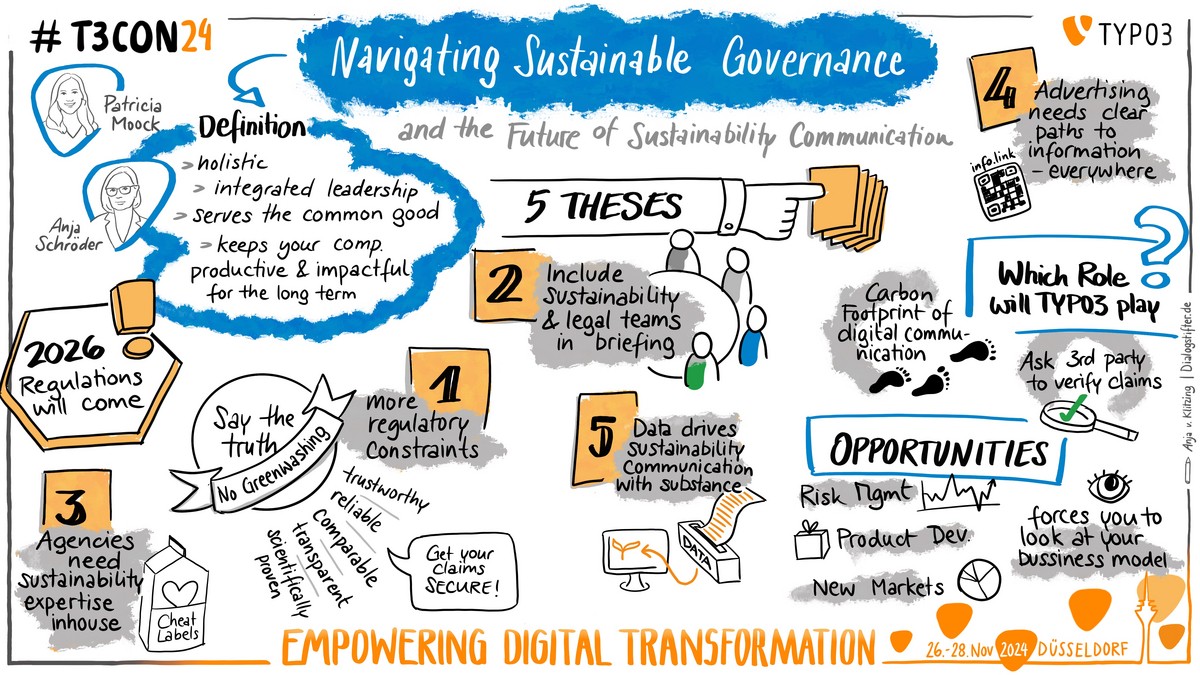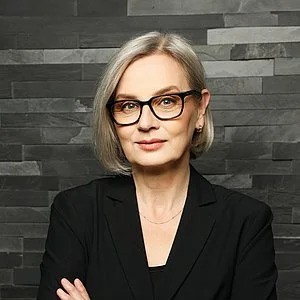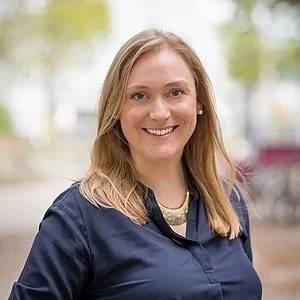
T3CON24 Recap – Navigating Sustainable Governance and the Future of Sustainability Communication
Introduction
Corporate sustainability has moved far beyond optional corporate social responsibility to become a core strategic consideration — and, increasingly, a regulatory requirement. At T3CON24, experts Patricia Moock and Anja Schröder from 4L Impact Strategies delivered a compelling session on Navigating Sustainable Governance and the Future of Sustainability Communication. Moock and Schröder presented five theses on how communication about sustainability will change in the future in response to an increasingly strict regulatory environment.

Speakers
Understanding Sustainable Governance
Patricia Moock began with a definition of sustainable governance: “Sustainability corporate governance is all about a holistic, integrated leadership, management and supervision which serves the common good, respects the environment, and keeps your company productive and impactful for the long term,” she explained.
She identified three critical messages within this definition:
- Sustainability must be integrated into the strategic core, not treated as isolated initiatives.
- Business decisions should account for future generations.
- Sustainability governance connects economic viability with long-term responsibility, spanning more than just one generation.
Moock contrasted this with the reality in many organizations, where corporate sustainability initiatives exist in silos without proper integration. “That’s why we need a strong sustainability governance that basically focuses around structures, processes, leadership, good monitoring, good steering,” she emphasized.
At the core of these structures, communication plays a vital role. Anja Schröder went on to elaborate five theses concerning how sustainability communication will evolve in the near future.
Thesis 1: Regulations Will Increasingly Transform Sustainability Communications
Anja Schröder illustrated how sustainability communication is becoming increasingly regulated with a compelling example: “Lufthansa, the German airline, got slapped on the wrist by the British advertising authority because they claimed, in a way, that flying is not so bad for the planet.” Despite Lufthansa arguing it was merely a metaphor, the Advertising Standards Authority (ASA) ruled that “you have to be very clear with what you say.”
The Lufthansa case exemplifies the broader issue of greenwashing. Indeed, an EU investigation revealed a troubling landscape: more than 50% of green claims are false, designed to mislead customers. This has led to decisive regulatory action.
Several key regulations are reshaping sustainability communications. The longstanding German Unfair Competition Act (UWG) and the European Unfair Commercial Practices Directive (UCPD) provide basic frameworks. However, a real game-changing regulation will come into force in September 2026: the Empowering Consumers for the Green Transition directive (EmpCo).

Under EmpCo, “If you just say, ‘We’re sustainable,’ that’s banned. If you just say, ‘We are green,’ that’s banned,” Schröder warned. Terms like “climate neutral”, “environmentally friendly”, and “climate positive” will be explicitly prohibited without scientific proof.
The forthcoming Green Claims Directive represents an even more significant shift. While current regulations allow claims to enter the market until challenged, “the Green Claims Directive wants to give consumers and companies a pathway to confirm that their green claim is compliant with the law before they even put the claim into the market,” Schröder explained.
To ensure sustainability compliance, companies should follow a four-step process:
- Verify the materiality of claims (addressing substantial aspects of offerings).
- Ensure completeness (covering entire products rather than selective aspects).
- Provide scientific basis.
- Obtain third-party verification.
Thesis 2: Cross-Departmental Collaboration Is Becoming Essential
Gone are the days when marketing decisions were made in isolation. An expanded team is essential because marketing professionals often lack expertise in complex sustainability topics.
Even sustainability-focused brands can unwittingly engage in greenwashing. Schröder shared a cautionary tale about GOT BAG, “a very famous sustainable brand” that faced backlash when marketing claims didn’t match reality. “The marketing guy wasn’t aware of the scientific data about how much recycled plastic was in the bag,” leading to a claim that it was entirely made of plastic retrieved from the ocean, rather than only 59%.
“In the world of green claims you will also have the legal team at the table, because communication is regulated, and you will have the sustainability expert of the company at the table,” Schröder explained.
Managing these multiple voices requires new processes. Schröder recommended: “Maybe you should start thinking about RACI charts to manage all voices in the room. And be sure, before you put something on the front end of your site, that everyone has checked the content and was aware that there is something new coming on the front end.”
Thesis 3: Agencies Need Sustainability Expertise In-House
“Agencies, if they do consultancy for clients, will need expertise on sustainability in-house in the future,” Schröder asserted. The reason is clear: “Consultancy means that you are sure and convinced that what you deliver is correctly within the guidelines of the law.”
Understanding sustainability terminology is particularly challenging. Schröder demonstrated this by asking the audience about the German phrase “Milch von freilaufenden Kühen,” which many misinterpreted as referring to cows running freely in fields. In reality, it only means “free in the stall” — a much more limited form of freedom.
“Either the agency must have the expertise on green claims or the company has it,” Schröder concluded. “If you want to go for consultancy, and if you want to be worth the money you get paid, agencies need sustainability expertise.”

Thesis 4: Advertising Needs Clear Paths to Information – Everywhere
New regulations require companies to make sustainability information readily accessible everywhere their products or services appear. Schröder emphasized a critical requirement: “If you want to claim, ‘My product is climate neutral,’ you may still claim that if you have science-based verification at hand — but then you run into trouble if you have just a tiny product, or you just have a picture of your product on your website, and the sustainability information is not addressed.”
The solution? Clear pathways to sustainability information from every touchpoint. Schröder highlighted an innovative approach from a Hamburg startup that leverages QR codes on packaging: “With the QR code, you come to a page where you will get all of the information that’s legally required to be provided, and we will give you even more information if you’re interested.”
For companies with extensive digital footprints, tracking down all potential green claims violations will be a major challenge. Artificial intelligence offers a potential solution: “If you have sites with 1500, 2000, 3000 pages, and the new ruling comes into effect, how will you be assured that you won’t have on your websites green claims that violate regulations? AI might help you find those content pieces,” Schröder suggested.
Thesis 5: Data Drives Sustainability Communication with Substance
The future of corporate sustainability communication will be firmly grounded in robust data. “Data, data, data drives sustainability,” Schröder said, noting how “companies are moving quickly to make their claims transparent and to make their production transparent, to make their supply chains transparent.”
However, this creates a critical technical challenge for communication professionals. Schroeder pointed out: “Companies will generate much more data that they want to and need to use for communication.” Under the Corporate Sustainability Reporting Directive (CSRD), companies may need to report “1200 possible data points” related to sustainability.
As a result, companies will create mountains of data. On the one hand this will be an invaluable asset for communications teams, since it is in this data that “the scientific proof for good communication and good sustainability communication is already located.” At the same time, the data will need to be sifted appropriately. As Schröder asked, “How does the information get from the data lake to the front page of your website?”
The Opportunity Behind the Challenge
During the Q&A session, an attendee raised concerns about the burden of sustainability regulations, noting that many CEOs view them as excessive and unnecessary. Patricia Moock countered with a strategic perspective: “There are huge opportunities in terms of implementing sustainability from a strategic point of view. It serves a huge purpose in terms of risk management, accessibility to pressure capital, and it gives huge innovation potential to your product development.”
Anja Schröder added a pragmatic view on regulations like CSRD: “The CSRD forces you to become aware of the risks your business model is facing because of climate change, and forces you to take a hard look at your negative impacts on natural resources.” As she noted, “You will change your business model because the planet is already striking back, so you will need to change it. And it’s better to know what you need to change than not knowing what to change.”
As organizations prepare for a future where corporate sustainability communication becomes increasingly regulated, the theses presented by Moock and Schröder provide valuable guidance. From integrating sustainability governance at the core of business operations to building cross-departmental teams and establishing data-driven communication strategies, companies that proactively adapt will turn compliance challenges into strategic opportunities.
Did you enjoy this recap? If you would like to relive all the exciting moments from T3CON24, be sure to check our our recap of the entire conference!



